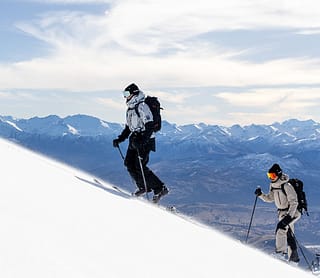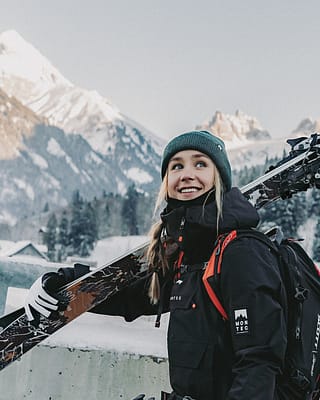Essential gear for backcountry adventures
If you’re ready to start your mountain safety journey, then dive into this guide and discover what equipment is essential to help you prepare for a safe off-piste experience.

Over the last few months, we’ve hosted a mini-series of MONTEC Safety Summit events dedicated to mountain safety. Delivered in partnership with ARVA, the goal of the training is to bring riders together and ensure they have the necessary training to keep them safe on the mountain.
When you’re planning to head into the backcountry, it’s vital to plan properly. Carrying avalanche safety equipment is mandatory once you leave the security of the groomed slopes. As such, it’s important that you’re carrying the right gear and have the right training to keep you and your fellow riders safe. We’ve rounded up the top five things you need to stay safe and comfortable as you venture into the backcountry.
Top 5 essentials for backcountry adventures
Correct layering
Picking the right gear for a day on the mountain is central to staying dry and comfortable. Starting with the layer closest to your skin, it’s important to manage your body temperature with moisture-wicking base layers that help keep you warm and dry throughout the day.
By choosing a shell jacket with a front zip, you have the choice to increase ventilation on the ascent as things warm up by opening up the front of your jacket. Or you can use the underarm zips to stay cool if you’re climbing in inclement weather! The men’s and women’s Fawk shell jackets are also equipped with large internal pockets, perfect for storing your gloves on the way up the mountain and for storing your skins on the descents! This keeps them warm, on hand, and ready for multiple tours!
Your shell jacket is perfect for pairing with a midlayer that can be stored in your backpack and pulled out when needed.
Sweaty hands can be a nightmare on the mountain, so consider packing a pair of liner gloves. These are perfect for when you’re hiking or touring up the mountain in dry weather, offering protection from the cold mountain air. They can also be worn under your insulated gloves or mittens and are perfect to keep on when adding or removing your skins.

Avalanche safety equipment
Even if you’ve planned your route meticulously and checked the weather before setting off, it’s important to be prepared in case of an avalanche … Did you know you’ve only got 15 minutes to maximise an avalanche victim’s chances of survival during a rescue?
If someone is buried, you'll need a transceiver to locate them. A transceiver is a device which helps you find skiers or snowboarders who are trapped under the snow. When paired with a shovel and probe, this trio of equipment provides the best chance of successfully completing an avalanche rescue on your own.
Finding someone buried is easier said than done. So, before you hit the mountains, make sure you know how to use your equipment. We recommend taking an avalanche safety course with licensed guides and instructors. In these courses, you not only gather important information and knowledge about mountain safety but also get hands-on experience with real-life scenarios to practice with your equipment, such as having a friend bury their transceiver somewhere and then locating and digging it out. It’s also important to have your transceiver serviced every 2-3 years (depending on frequency of use) to help ensure continued performance.

Airbag backpacks
For additional protection in avalanche situations, airbag backpacks can help keep you on the surface of an avalanche. This happens because of a law called ‘inverse segregation’, which means that smaller snow particles will sink to the bottom of the avalanche while larger objects move towards the surface. As such, when the airbag deploys, it adds additional volume to your body, helping to increase your chances of staying on the surface and helping reduce your chances of being buried.
If you’re choosing an airbag for the first time, there are a few things to consider:
- Compressed gas versus electric-powered inflation
- Trigger handle or cable system
- Inflation power (how quickly the airbag inflates once triggered)
- Airbag number and positioning. A backpack with two airbags offers a backup if one is punctured during a slide. The positioning of an airbag also increases the surface area and boosts your chances of staying on top of an avalanche.
- Weight of the backpack
- The comfort of the backpack

Helmet
Helmets are a crucial safety accessory that should be worn at all times while riding. A good helmet will help to prevent head and brain injuries during crashes and falls, and in the backcountry, when rescue might be hours away, this is more vital than ever. We recommend getting a helmet that is safety certified, and equipped with technology like MIPS or SPIN to further reduce the risk of brain injury during rotational impacts.
Backcountry-specific helmets are available from some manufacturers, which offer special features like built-in RECCO reflection for added traceability during rescues, MFC medical ID patches so that rescue teams can learn vital information if you’re unconscious, and adjustable ventilation ideal for strenuous climbs. These helmets have the highest safety ratings and are the best choice for any aspiring backcountry rider.
Other essentials
Once you’ve got your layering set-up and safety gear, you’re almost ready to go! But, before you head out the door, there are just a couple more things to add to your bag to help keep you safe.
- Additional goggle lenses with different VLT ratings help in variable visibility and weather conditions. It’s also worth packing sunglasses too, for those bluebird climbs!
- An insulated water bottle with help prevent your water from freezing and keep you on top of your fluid intake. Adding electrolyte powders or tablets will also ensure you feel fresh and avoid muscle fatigue and cramps.
- Food and snacks are always an essential worth packing as you’ll be burning a lot of calories on the mountain and you never know how long you’ll be out there if something goes wrong.
- Sunscreen is imperative as UV radiation from the sun is more intense at altitude. With every 1000m gained in altitude, UV levels increase by approximately 10%. Avoid sunburn and skin damage with a sunscreen suited to use at altitude, and don’t forget to reapply during the day, especially when you’re sweating!
- A first aid kit is also vital to carry. From serious incidents and wounds to blisters and minor cuts, having a first aid kit on hand can mean the difference between life and death when medical attention is hours away.

But choosing the right gear is just the beginning…
Learning to read snow conditions, undergoing training provided by qualified instructors, and consistent practice are all crucial to reducing the risk of avalanches and for staying safe on your mountain adventures! Join the MONTEC community and be the first to hear about future MONTEC safety events hosted in collaboration with ARVA. In the meantime, you can start sharpening your knowledge now with the ARVA academy, which provides training through its online snow safety program.
